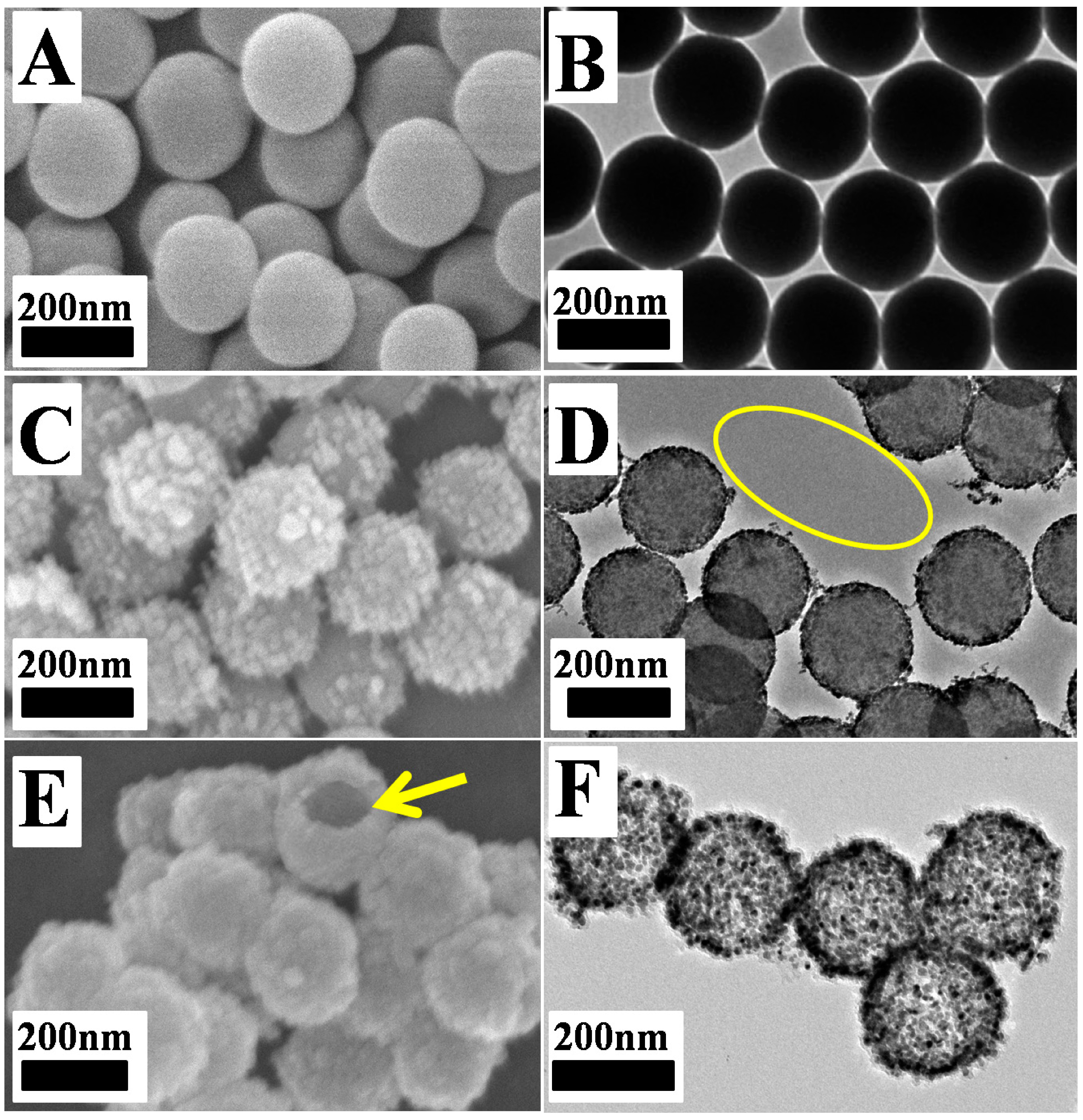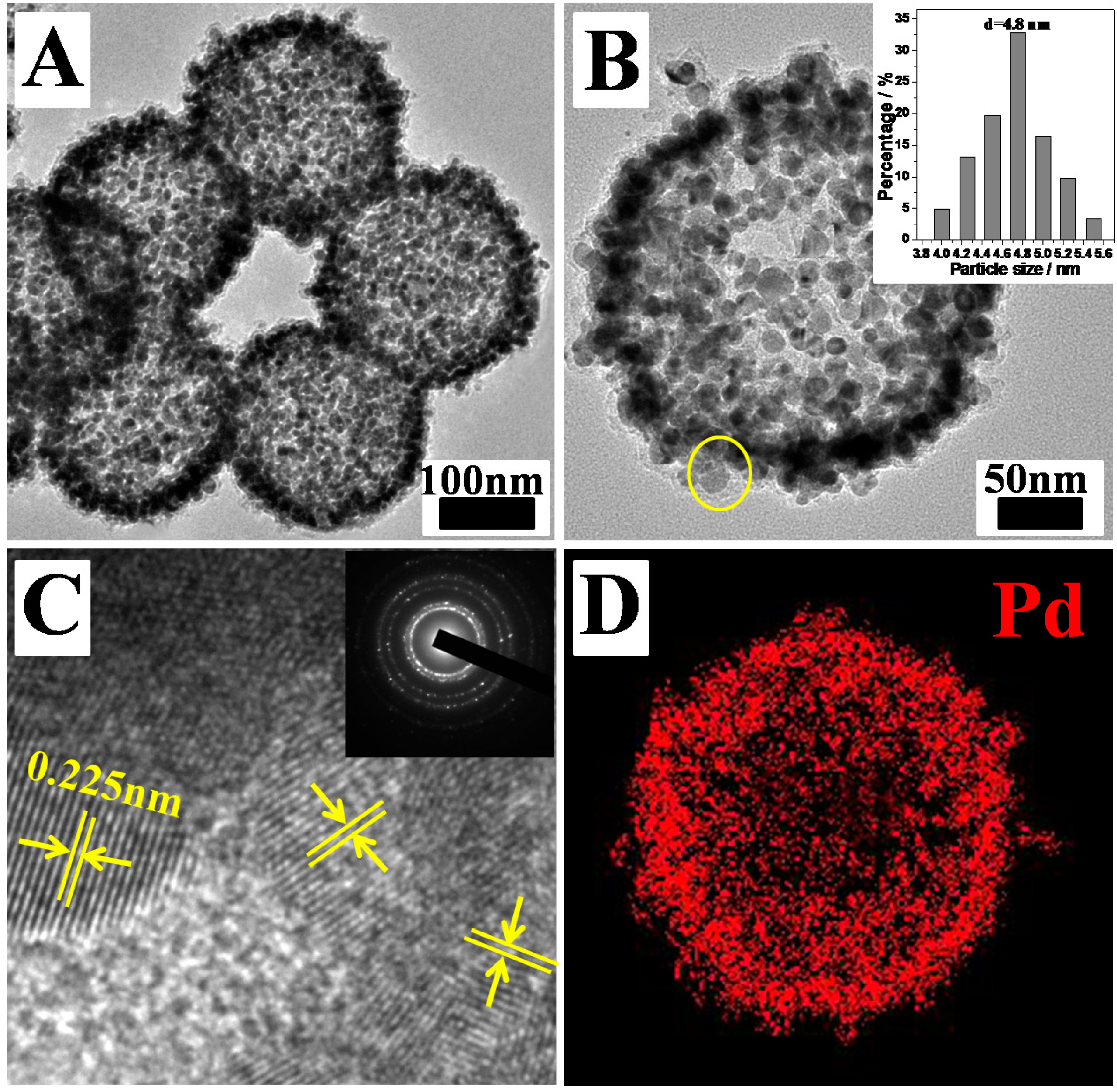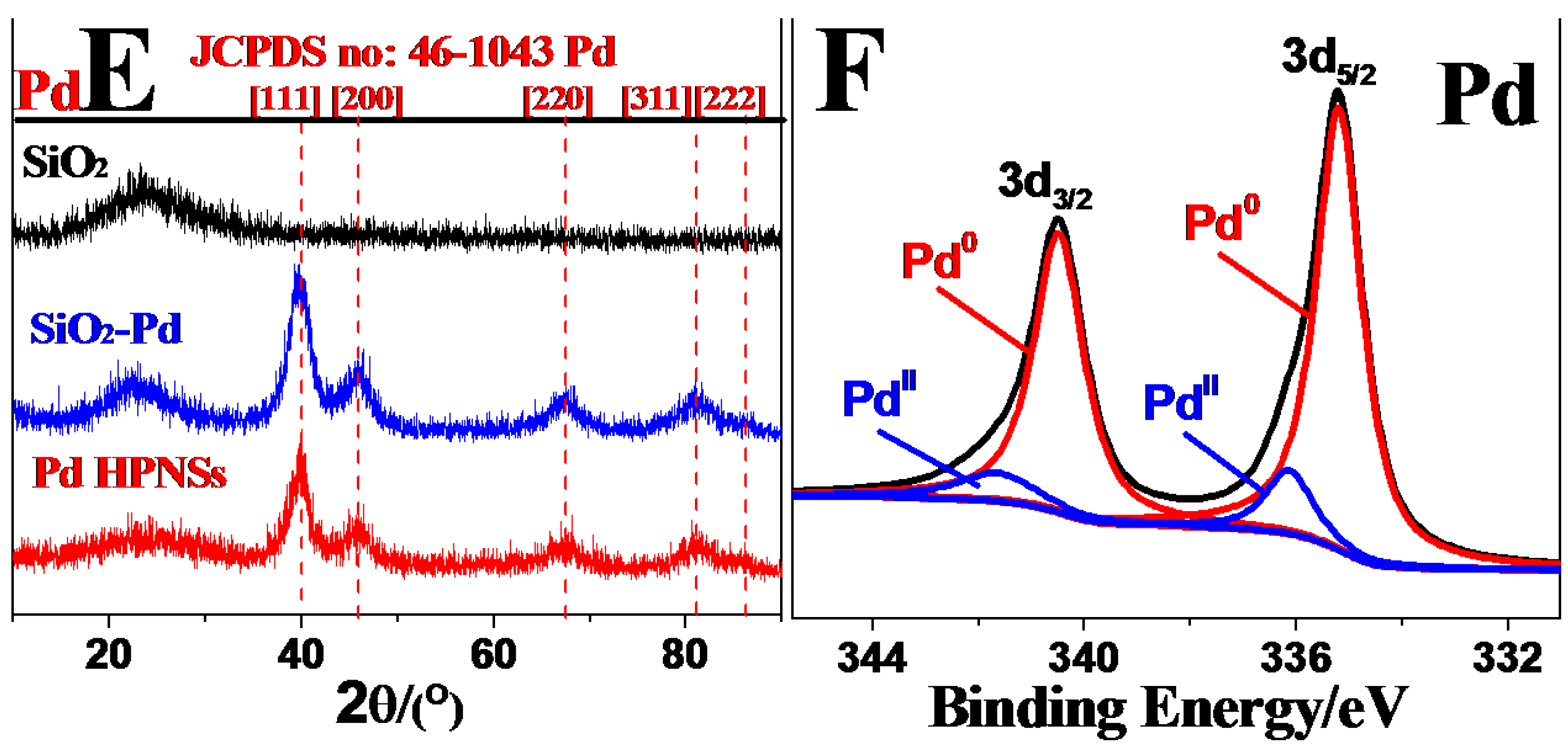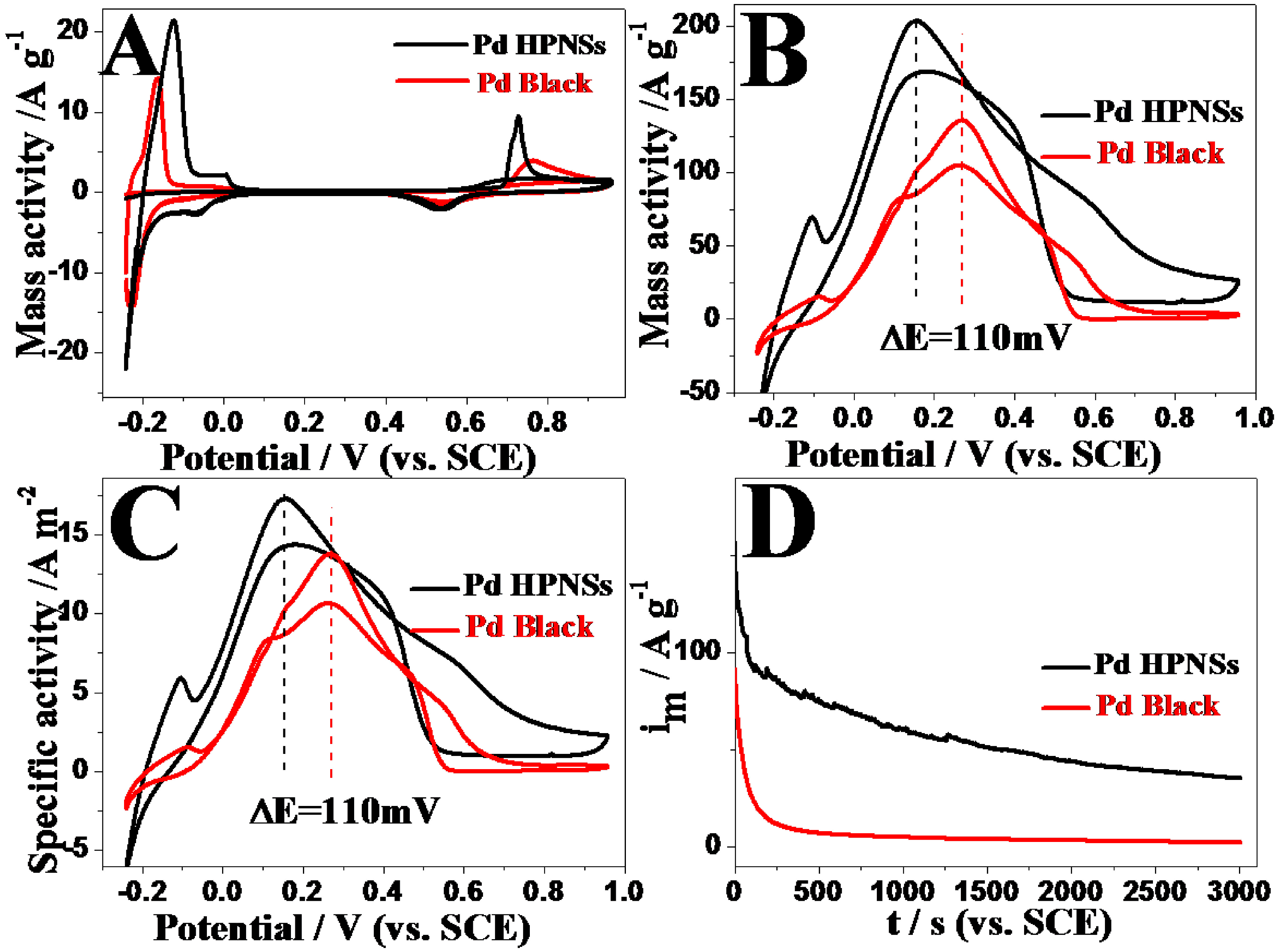Sacrificial Template-Based Synthesis of Unified Hollow Porous Palladium Nanospheres for Formic Acid Electro-Oxidation
Abstract
:1. Introduction
2. Results and Discussion
2.1. Physicochemical Characterization of Pd HPNSs





2.2. Electrocatalytic Tests

3. Experimental Section
3.1. Reagents and Chemicals
3.2. Synthesis of Hollow porous Pd Nanospheres (Pd HPNSs)
3.3. Electrochemical Instrument
3.4. Instruments
4. Conclusions
Acknowledgments
Author Contributions
Conflicts of Interest
References
- Nelson, N.; Manzano, J.; Sadow, A.; Overbury, S.; Slowing, I. Selective Hydrogenation of Phenol Catalyzed by Palladium on High-Surface-Area Ceria at Room Temperature and Ambient Pressure. ACS Catal. 2015, 5, 2051–2061. [Google Scholar] [CrossRef]
- Cervantes, C.; Alamo, M.; Garcia, J. Hydrogenation of Biomass-Derived Levulinic Acid into γ-Valerolactone Catalyzed by Palladium Complexes. ACS Catal. 2015, 5, 1424–1431. [Google Scholar] [CrossRef]
- Zhu, F.; Wang, Z. Palladium-Catalyzed Coupling of Azoles or Thiazoles with Aryl Thioethers via C−H/C−S Activation. Org. Lett. 2015, 2. [Google Scholar] [CrossRef] [PubMed]
- Zhao, G.; Chen, C.; Yue, Y.; Yu, Y.; Peng, J. Palladium(II)-Catalyzed Sequential C−H Arylation/Aerobic Oxidative C−H Amination: One-Pot Synthesis of Benzimidazole-FusedPhenanthridines from 2-Arylbenzimidazoles and Aryl Halides JOC. J. Org. Chem. 2014, 11. [Google Scholar] [CrossRef] [PubMed]
- Yang, S.; Shen, C.; Lu, X.; Tong, H.; Zhu, J.; Zhang, X.; Gao, H. Preparation and electrochemistry of graphene nanosheets–multiwalled carbon nanotubes hybrid nanomaterials as Pd electrocatalyst support for formic acid oxidation. Electrochim. Acta 2012, 62, 242–249. [Google Scholar] [CrossRef]
- Yang, S.; Dong, J.; Yao, Z.; Shen, C.; Shi, X.; Tian, Y.; Lin, S.; Zhang, X. One-Pot Synthesis of Graphene-Supported Monodisperse Pd Nanoparticles as Catalyst for Formic Acid Electro-oxidation. Sci. Rep. 2014, 3. [Google Scholar] [CrossRef] [PubMed]
- Wang, Y.; Liu, H.; Wang, L.; Wang, H.; Du, X.; Wang, F.; Qi, T.; Lee, J.; Wang, X. Pd catalyst supported on a chitosan-functionalized large-area 3D reduced graphene oxide for formic acid electrooxidation reaction. J. Mater. Chem. A 2013, 4. [Google Scholar] [CrossRef]
- Chang, J.; Sun, X.; Feng, L.; Xing, W.; Qin, X.; Shao, G. Effect of nitrogen-doped acetylene carbon black supported Pd nanocatalyst on formic acid electrooxidation. J. Power Sources 2013, 239, 94–102. [Google Scholar] [CrossRef]
- Bai, Z.; Yan, H.; Wang, F.; Yang, L.; Jiang, K. Electrooxidation of formic acid catalyzed by Pd Nanoparticles supported on multi-walled carbonnanotubes with sodium oxalate. Ionics 2013, 19, 543–548. [Google Scholar] [CrossRef]
- Fu, G.; Jiang, X.; Tao, L.; Chen, Y.; Lin, J.; Zhou, Y.; Tang, Y.; Lu, T. Polyallylamine Functionalized Palladium Icosahedra: One-Pot Water-Based Synthesis and Their Superior Electrocatalytic Activity and Ethanol Tolerant Ability in Alkaline Media. Langmuir 2013, 29, 4413–4420. [Google Scholar]
- Fu, G.; Wu, K.; Jiang, X.; Tao, L.; Chen, Y.; Lin, J.; Zhou, Y.; Wei, S.; Tang, Y.; Lu, T.; Xia, X. Polyallylamine-directed green synthesis of platinum nanocubes. Shape and electronic effect codependent enhanced electrocatalytic activity. Phys. Chem. Chem. Phys. 2013, 15, 3793–3802. [Google Scholar] [CrossRef] [PubMed]
- Yang, Y.; Wang, F.; Yang, Q.; Hu, Y.; Yan, H.; Chen, Y.-Z.; Liu, H.; Zhang, G.; Lu, J.; Jiang, H.-L.; Xu, H. Hollow Metal–Organic Framework Nanospheres via Emulsion-Based Interfacial Synthesis and Their Application in Size-Selective Catalysis. ACS Appl. Mater. Interfaces 2014, 6, 18163–18171. [Google Scholar] [CrossRef] [PubMed]
- Yang, Z.; Li, Z.; Yang, Y.; Xu, Z.J. Optimization of ZnxFe3–xO4 Hollow Spheres for Enhanced Microwave Attenuation. ACS Appl. Mater. Interfaces 2014, 6, 21911–21915. [Google Scholar] [CrossRef] [PubMed]
- Wang, M.; Zhang, W.; Wang, J.; Wexler, D.; Poynton, S.D.; Slade, R.C. T.; Liu, H.; Winther-Jensen, B.; Kerr, R.; Shi, D.; Chen, J. PdNi Hollow Nanoparticles for Improved Electrocatalytic Oxygen Reduction in Alkaline Environments. ACS Appl. Mater. Interfaces 2013, 5, 12708–12715. [Google Scholar] [CrossRef] [PubMed]
- Wang, L.; Imura, M.; Yamauchi, Y. Tailored Design of Architecturally Controlled Pt Nanoparticles with Huge Surface Areas toward Superior Unsupported Pt Electrocatalysts. ACS Appl. Mater. Interfaces 2012, 4, 2865–2869. [Google Scholar] [CrossRef] [PubMed]
- Chen, D.; Cui, P.; He, H.; Liu, H.; Yang, J. Highly Catalytic Hollow Palladium Nanoparticles Derived From Silver@silver–palladium Core–shell Nanostructures for the Oxidation of Formic Acid. J. Power Sources 2014, 272, 152–159. [Google Scholar] [CrossRef]
- Wu, P.; Wang, H.; Tang, Y.; Zhou, Y.; Lu, T. Three-Dimensional Interconnected Network of Graphene-Wrapped Porous Silicon Spheres: In Situ Magnesiothermic-Reduction Synthesis and Enhanced Lithium-Storage Capabilities. ACS Appl. Mater. Interfaces 2014, 6, 3546–3552. [Google Scholar] [CrossRef] [PubMed]
- Malolepszy, A.; Mazurkiewicz, M.; Mikolajczuk, A.; Stobinski, L.; Borodzinski, A; Mierzwa, B.; Lesiak, B.; Zemek, J.; Jiricek, P. Influence of Pd-Au/MWCNTs surface treatment on catalytic activity in the formic acid electrooxidation. Phys. Status Solidi C 2011, 8, 3195–3199. [Google Scholar] [CrossRef]
- Qu, K.; Wu, L.; Ren, J.; Qu, X. Natural DNA-Modified Graphene/Pd Nanoparticles as Highly Active Catalyst for Formic Acid Electro-Oxidation and for the Suzuki Reaction. ACS Appl. Mater. Interfaces 2012, 4, 5001–5009. [Google Scholar] [CrossRef] [PubMed]
- Zhang, L.; Wan, L.; Ma, Y.; Chen, Y.; Zhou, Y.; Tang, Y.; Lu, T. Crystalline Palladium–cobalt Alloy Nanoassemblies with Enhanced Activity and Stability for The Formic Acid Oxidation Reaction. Appl. Catal. B 2013, 229–235. [Google Scholar] [CrossRef]
- Zhang, L.; Sui, Q.; Tang, T.; Chen, Y.; Zhou, Y.; Tang, Y.; Lu, T. Surfactant-free palladium nanodendrite assemblies with enhanced electrocatalytic performance for formic acid oxidation. Electrochem. Commun. 2013, 32, 43–46. [Google Scholar] [CrossRef]
- Ott, A.; Yu, X.; Hartmann, R.; Rejman, J.; Schütz, A.; Ochs, M.; J. Parak, W.; Carregal-Romero, S. Light-Addressable and Degradable Silica Capsules for Delivery of Molecular Cargo to the Cytosol of Cells. Chem. Mater. 2015. [Google Scholar] [CrossRef]
- Dahlberg, K.A.; Schwank, J.W. Synthesis of Ni@SiO2 Nanotube Particles in a Water-in-Oil Microemulsion Template. Chem. Mater. 2012, 24, 2635–2644. [Google Scholar] [CrossRef]
- Kim, S.M.; Jeon, M.; Kim, K.W.; Park, J.; Lee, I.S. Postsynthetic Functionalization of a Hollow Silica Nanoreactor with Manganese Oxide-Immobilized Metal Nanocrystals Inside the Cavity. J. Am. Chem. Soc. 2013, 135, 15714–15717. [Google Scholar] [CrossRef] [PubMed]
- Deng, T.-S.; Marlow, F. Synthesis of Monodisperse Polystyrene@Vinyl-SiO2 Core–Shell Particles and Hollow SiO2 Spheres. Chem. Mater. 2011, 24, 536–542. [Google Scholar] [CrossRef]
© 2015 by the authors; licensee MDPI, Basel, Switzerland. This article is an open access article distributed under the terms and conditions of the Creative Commons Attribution license (http://creativecommons.org/licenses/by/4.0/).
Share and Cite
Qiu, X.; Zhang, H.; Dai, Y.; Zhang, F.; Wu, P.; Wu, P.; Tang, Y. Sacrificial Template-Based Synthesis of Unified Hollow Porous Palladium Nanospheres for Formic Acid Electro-Oxidation. Catalysts 2015, 5, 992-1002. https://doi.org/10.3390/catal5020992
Qiu X, Zhang H, Dai Y, Zhang F, Wu P, Wu P, Tang Y. Sacrificial Template-Based Synthesis of Unified Hollow Porous Palladium Nanospheres for Formic Acid Electro-Oxidation. Catalysts. 2015; 5(2):992-1002. https://doi.org/10.3390/catal5020992
Chicago/Turabian StyleQiu, Xiaoyu, Hanyue Zhang, Yuxuan Dai, Fengqi Zhang, Peishan Wu, Pin Wu, and Yawen Tang. 2015. "Sacrificial Template-Based Synthesis of Unified Hollow Porous Palladium Nanospheres for Formic Acid Electro-Oxidation" Catalysts 5, no. 2: 992-1002. https://doi.org/10.3390/catal5020992
APA StyleQiu, X., Zhang, H., Dai, Y., Zhang, F., Wu, P., Wu, P., & Tang, Y. (2015). Sacrificial Template-Based Synthesis of Unified Hollow Porous Palladium Nanospheres for Formic Acid Electro-Oxidation. Catalysts, 5(2), 992-1002. https://doi.org/10.3390/catal5020992




